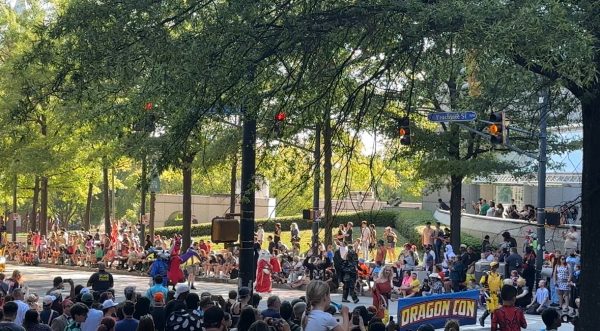Art for the People Project unveils bronze statue “What Sonia Said”
On Sep. 12, the Beacon Hill Black Alliance for Human Rights paired up with Atlanta Afrofuturist artist Ellex Swavoni to unveil the latter’s bronze statue “What Sonia Said”. The statue, which features a quote from the poem “Catch the Fire” by Sonia Sanchez, is slated to replace the former Confederate monument at the Decatur square. The former monument was removed in June 2020 following the mass protest movement spurred by the murder of George Floyd the previous month and activism by local organizations.
Unveiling a statue has been the goal of Beacon Hill’s Art for the People project, which was born out of the Confederate monument’s removal. A quote by writer and activist James Baldwin has been used to describe the mission of Art for the People: “the purpose of art is to lay bare the questions that have been hidden by the answers.” The organization is named after the historic Beacon Hill community, which was created by formerly enslaved people after the Civil War, and was destroyed by unfair urban policy by Decatur’s government.

The event opened with a musical performance by string duet “Unknown Lyric”. Afterwards, several speakers, including Beacon Hill members and local officials, briefly addressed the community in relation to the statue.
One of the speakers was Zana Sanders, a researcher at University of California, Berkeley, who joined Art for the People to help educate people about racism through art.
“We have a real opportunity to meet as a community, as a group of people, and think quite deeply around the roles of arts in our community and also around how we can use these platforms to address social inequality,” Sanders said.
Although she has been a part of the project for over a year, Sanders was always focused on the education aspect of Art for the People.
“I think someone has to do the work of educating people. It’s not just the art itself…someone needs to talk about what the art represents,” she explained. “It’s great to have it, but it’s also better to contextualize it and that’s what I see my role as doing.”
This is why Sanders hosted virtual artist workshops for members of the community during a four week span, from Sep. 22 to Oct. 16.
“It is an opportunity for us to have a deeper engagement with the artwork itself, for us to think about the histories that it represents, and again how we continue to do the work of contextualizing that,” Sanders said.
Sanders added that the workshop was more of a collaborative project than a teaching and learning experience. “I see it as a co-learning experience where we all brought our own understandings, our own experience and our own knowledge to the study of this work,” she explained.
The statue was unveiled during a time when many other Decatur monuments were changing due to increased discussion of the city’s past. On Oct. 12, the cannon commemorating the expulsion of the Muscogee people from Decatur in 1836 was removed from the square. Sanders believes that artifacts like the cannon have real value on top of symbolism.
“Public art like this is very reflective of public history, in terms of what it is that we choose to remember, what it is that we choose to value in our community, and what it is we choose to teach about in our community… it’s not just an issue of symbolic representation,” Sanders said.
The “What Sonia Said” statue, according to Sanders, embodies this concept.
“We need to build greater understanding as groups of people around a different code that’s not built on racism, that’s not built on these sort of hierarchies of race and class and religion and all these other things that we do to divide people,” she said.


Adrien Tirouvanziam (Class of 2022) enjoys sports, music and academics all up to a certain extent. If you look down enough, you can find him playing...

Aidan Rogers is a writer and editor for 3ten and Carpe Diem. He has written for the site and magazine since 2019 and started in the Convergence Media program...







